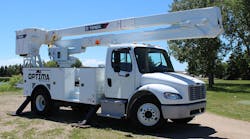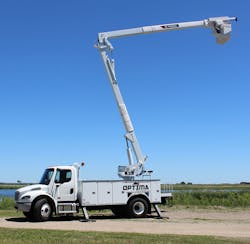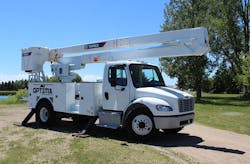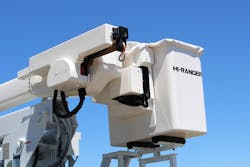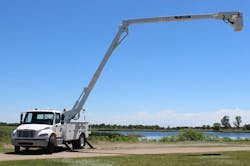Hydraulics technology plays an important role in the aerial devices the utility industry uses to reach and service electric lines. Cylinders on these truck-mounted lifts operate the booms that raise buckets or platforms carrying workers and equipment to heights that may reach up to 65 ft., with side-reach capabilities that can exceed 50 ft. on some models.
When Terex Utilities designed its Optima series of Hi-Ranger devices, the company addressed performance, productivity, and maintenance—three top concerns of its electric utility customers, according to Joe Caywood, director of marketing at Terex, Watertown, S.D. Starting with its proven Hi-Ranger design, the company incorporated several product improvements that provide greater vehicle payload capacity, better boom speeds, enhanced side reach and ground access, and features that improve maintenance access and reliability.
Terex Optima Series aerial lift uses hydraulics to raise and position utility workers for their work on distribution lines, as well as for handling materials and powering tools.
Machine Benefits from Hydraulic Upgrades
Although some of the upgrades required structural changes—such as using high-strength steel to reduce aerial weight and increase vehicle payload capacity—others focused on modifications to the equipment’s hydraulic system. For example, a higher-capacity pump provides greater flow, which translates into higher boom speed and allows operating multiple functions simultaneously with no reduction in speed. This also called for upgrading some valves to accommodate the higher flow rates, as well as improving the routing of hydraulic lines. Ultimately, these improvements boost the machine’s productivity.
The Optima aerial lifts are available with either an open- or closed-center load-sensing hydraulic system, with pilot-operated valves used on the closed-center version. The open-center system uses a vane pump, while the closed-center system has a pressure-compensated piston pump. A single-stick control is used in the work bucket for both systems, whereas the ground controls use individual levers.
Boom pivots were redesigned from previous versions to allow lower travel height, which also required changes in cylinder configuration to achieve optimal combination of speed and strength.
Terex engineers modified the pivot pinning positions of the boom structure and used cylinders with longer strokes to expand the machines’ side reach capability. Redesigning the boom pivots also achieved lower travel height, which also required some changes in the cylinder configuration to provide the optimal combination of strength and speed.
To reduce maintenance and increase reliability, all fittings above the boom rotation level are use O-ring face seals, rather than the JIC fittings commonly used in the industry. Although the JIC fittings are suitable for the hydraulic systems in most of these types of machines, Terex engineers wanted the additional leak resistance offered by O-ring seals for the demanding environments in which these lifts sometimes operate.
An optional hydraulic articulating jib and winch mechanism facilitates material handling while the operator is working aloft.
An optional hydraulic articulating jib and winch mechanism facilitates material handling while the operator is aloft. The jib is operated by a hydraulic cylinder and articulates, extends, and retracts. The winch is driven by a hydraulic motor to raise or lower the load. Together they can place material in the best position for installation, for removal, or to hold it so the operator can accomplish the task at hand. Other options include a hydraulic oil cooler.
Hydraulics for Power to Spare
Hydraulic tools can be connected to the aerial device, including drills, impact wrenches, saws, and crimpers for use by operators in the bucket. Terex machines in this series regulate pressure down to 2,250 psi and produce maximum flows of 5- to 7-gpm flow for tool functions. A cylinder controls platform tilt to keep the bucket level during operation and allows for override to accommodate operator working position preference and to ease cleaning out the bucket. A cylinder is also used to rotate the bucket when needed on these machines.
Modified pivot pinning positions of the boom structure and the use of cylinders with increased stroke helped expand the machines’ side reach capability.
Insulated aerial devices such as these have two insulation gaps, one in the lower boom and one in the upper boom. Only non-conductive material is allowed to pass through these gaps, so non-conductive hose is used to route hydraulic fluid to and from the boom tip. There, hydraulics powers a winch and operates the jib, powers hydraulic tools, operates tilt and leveling functions, and provides control of the device.
